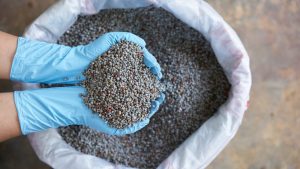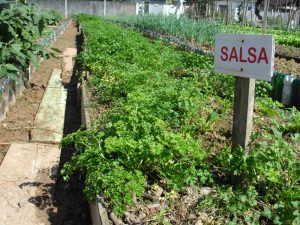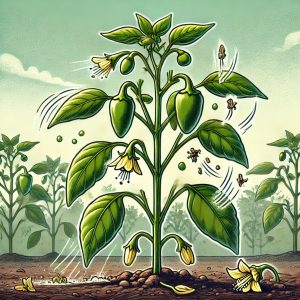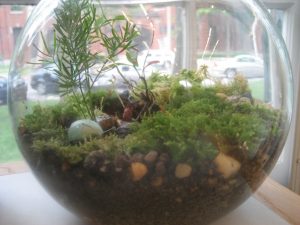Last Updated on February 29, 2024 by teamobn
You don’t need a lot of space to grow fresh vegetables, herbs, and fruits. All you really need is a container, a growing medium, water, and sun, and you can start growing some tasty things. You can even make an attractive wine barrel planter for your garden.
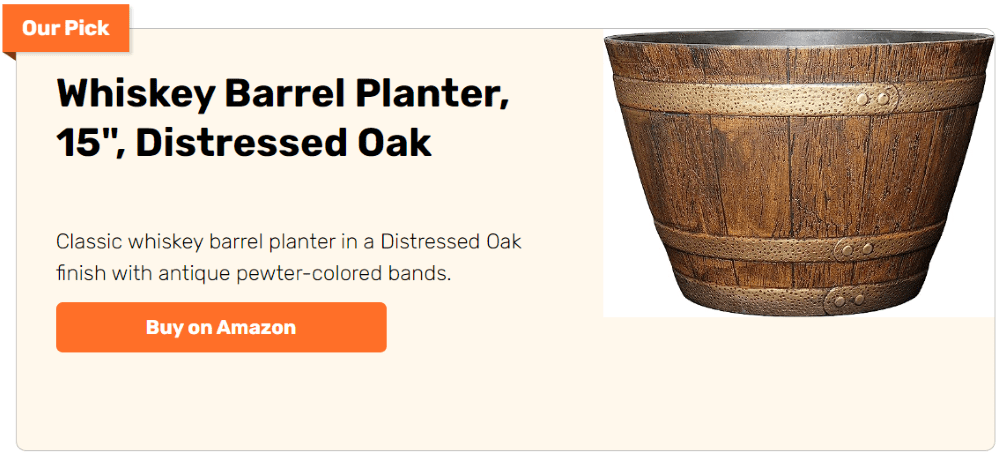
You know what they say: if there’s a will, there’s always a way. So here’s a great garden idea for you.
If you have limited gardening space and some old wine barrels, this DIY wine barrel planter project is for you. You simply have had to saw the barrels up and divide them into several tiers. If you want more compartments, you can use old pallets.
This Wine barrel planter has an old rustic look to it that certainly adds to the charm. So it’s really both decorative and functional. Don’t you just love multi-purpose projects?
Building a Wine Barrel Planter
Contents
Materials
- Wine Barrel
- 2 strips of Wood ½x6x26”
- 7 strips of Wood 1/2×10-12” (length varies with mitered corners)
- Wood Screws
- Twine
Tools
- Jig Saw
- Compound Miter Saw
- Power Screwdriver with Drill Bit
Instructions
Step 1: Prepare the Wine Barrel
- Inspect the wine barrel for any damage or rot. Repair as necessary to ensure it is structurally sound.
- Clean the barrel thoroughly to remove any residue or debris. Allow it to dry completely.
Step 2: Marking the Barrel for Cutting
- Decide the height at which you want to cut the barrel for your planter. A good starting point is approximately two-thirds of its height.
- Mark a straight line around the circumference of the barrel at your chosen height.
Step 3: Cutting the Barrel
- Using the jig saw, carefully cut along the marked line to separate the barrel into two sections. You will use the bottom section for your planter.
Step 4: Preparing the Base
- If the bottom section of your barrel does not have a bottom, use one of the ½x6x26” wood strips to create a new base.
- Measure and cut the wood strip to fit the interior diameter of the barrel’s bottom. Use the compound miter saw for precise cuts.
- Secure the base to the barrel using wood screws and the power screwdriver. Drill pilot holes to prevent the wood from splitting.
Step 5: Adding Internal Supports (Optional)
- If your planter will hold heavy soil, consider adding internal supports. Cut additional wood strips to fit inside the barrel for added strength.
- Secure these supports along the interior sides of the barrel with wood screws.
Step 6: Creating Tiered Sections (Optional)
- To create tiered sections for planting, measure and cut the remaining wood strips with mitered corners to fit inside the barrel.
- Arrange the strips in a pattern that suits your design, then secure them with wood screws. This step is optional but adds visual interest and functionality.
Step 7: Drilling Drainage Holes
- Flip the barrel over so the base is facing upwards.
- Drill several drainage holes in the bottom to ensure excess water can escape. Space the holes evenly for optimal drainage.
Step 8: Finishing Touches
- Sand any rough edges for safety and aesthetic appeal.
- You may choose to treat the wood with a sealant suitable for outdoor use to prolong its life. Ensure the sealant is safe for use with plants.
Step 9: Filling Your Planter
- Position your wine barrel planter in its desired location before filling, as it will be heavy once filled.
- Fill the planter with a high-quality potting mix suitable for the plants you intend to grow.
- Plant your chosen vegetables, herbs, or flowers, and water them thoroughly.
Step 10: Adding Twine Accents (Optional)
- Wrap twine around the exterior of the barrel for a decorative touch. Secure the ends with a knot or discreetly tuck them under wrapped layers.
Pest and Disease Management in Wine Barrel Planters
Wine barrel planters are an excellent choice for gardeners looking to add a touch of rustic elegance to their outdoor spaces. While they offer many benefits, including versatility and aesthetic appeal, they also require vigilant care to prevent and manage pests and diseases. Understanding how to tackle these challenges can help maintain the health of your plants and ensure your wine barrel garden remains a vibrant part of your outdoor living area.
Preventative Measures
Good Hygiene Practices
Keeping your wine barrel planter clean is the first step in preventing pest and disease problems. Remove dead leaves and debris regularly to reduce hiding spots for pests and eliminate potential breeding grounds for disease.
Proper Watering Techniques
Overwatering can lead to root rot and other fungal diseases in wine barrel planters. Ensure your planter has adequate drainage and water your plants according to their needs.
Choosing Disease-Resistant Varieties
When selecting plants for your wine barrel planter, opt for varieties known to be resistant to pests and diseases. This proactive approach can significantly reduce the likelihood of problems developing.
Pest Management
Regular Monitoring
Check your plants frequently for signs of pest activity. Early detection is key to preventing an infestation from spreading. Look for common symptoms like chewed leaves, sticky residue, or pests.
Physical Removal
For small infestations, manually removing pests from your plants can be effective. This can include picking off insects or gently washing them away with water.
Natural Predators
Encouraging natural predators, such as ladybugs and lacewings, can help control pest populations in wine barrel planters. These beneficial insects can be attracted to your garden with specific plants or purchased from garden centers.
Organic Pesticides
If necessary, use organic pesticides as a last resort. Neem oil and insecticidal soaps are safer choices for your plants, the environment, and beneficial insects.
Disease Management
Proper Air Circulation
Ensure your wine barrel planter is not overcrowded, as poor air circulation can promote fungal diseases. Pruning plants to allow air and light to penetrate can help prevent issues.
Fungicides
For fungal diseases, applying an appropriate fungicide may be necessary. Choose a product that is safe for use in vegetable gardens if you are growing edible plants. Always follow the label instructions carefully.
Crop Rotation
If you grow vegetables in your wine barrel planter, practice crop rotation to prevent soil-borne diseases. Changing the types of plants grown in each barrel yearly can reduce disease carryover.
Click on any image to start the lightbox display. Use your Esc key to close the lightbox.
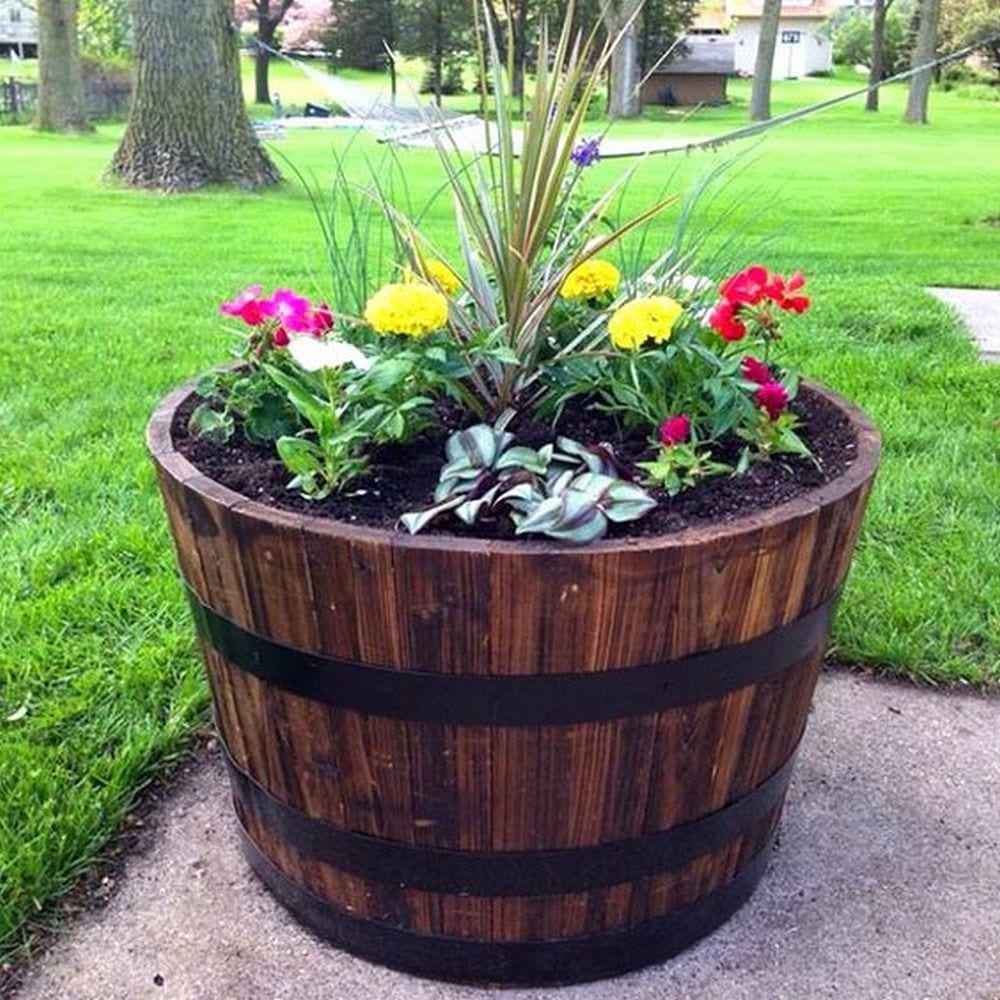
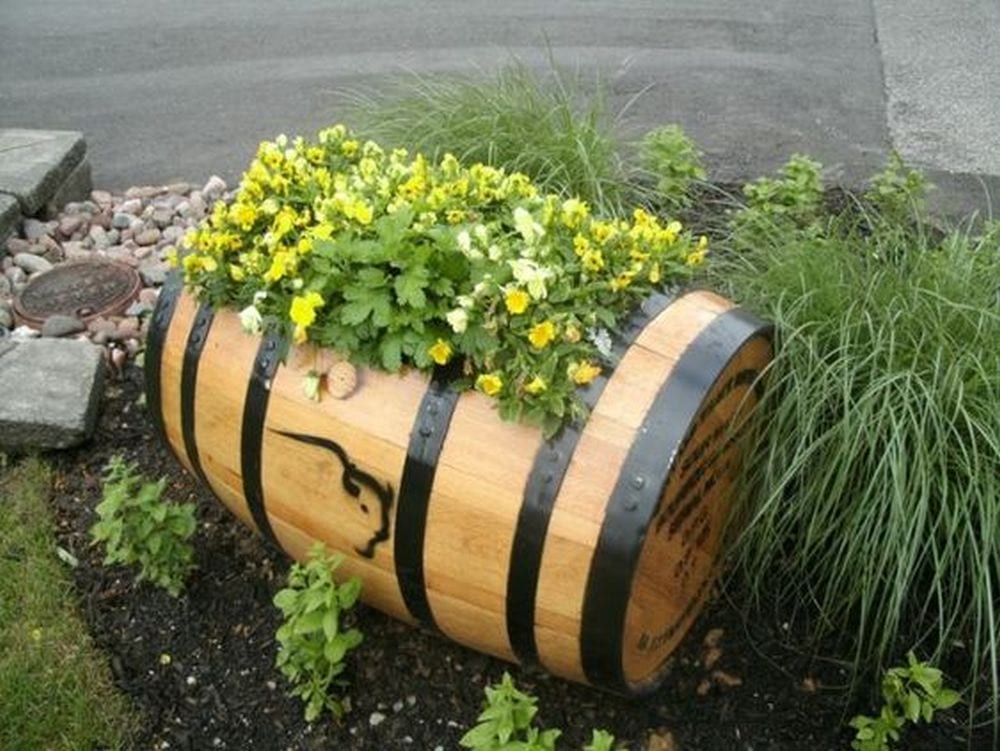
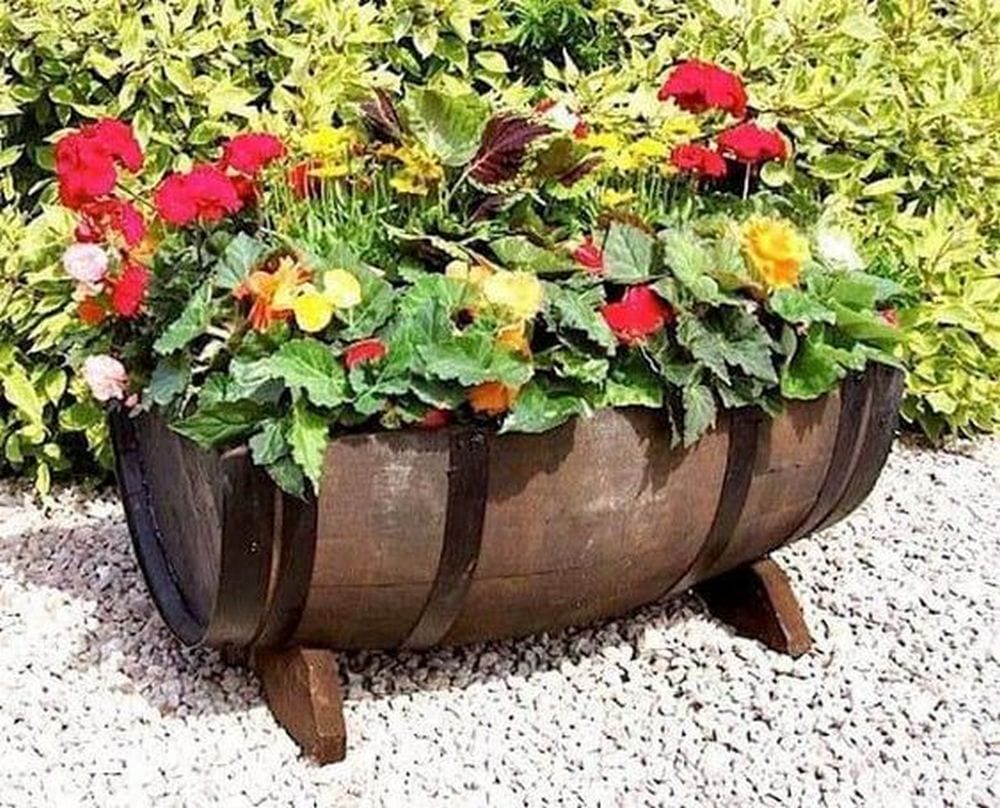

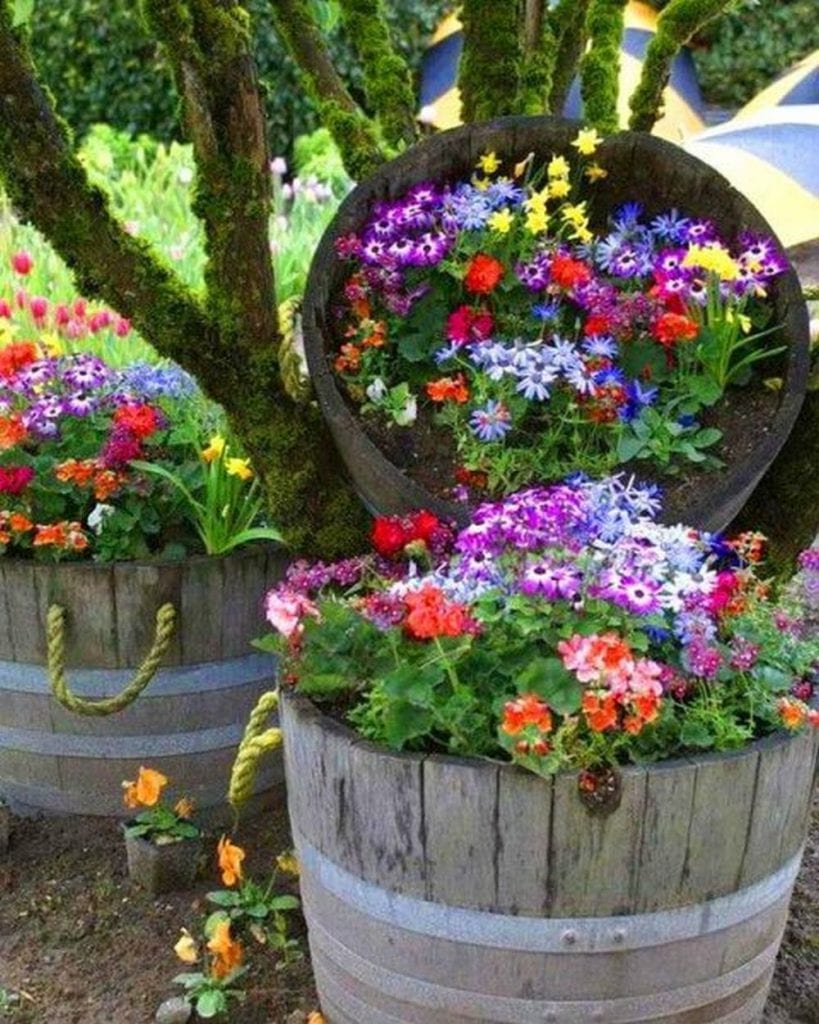
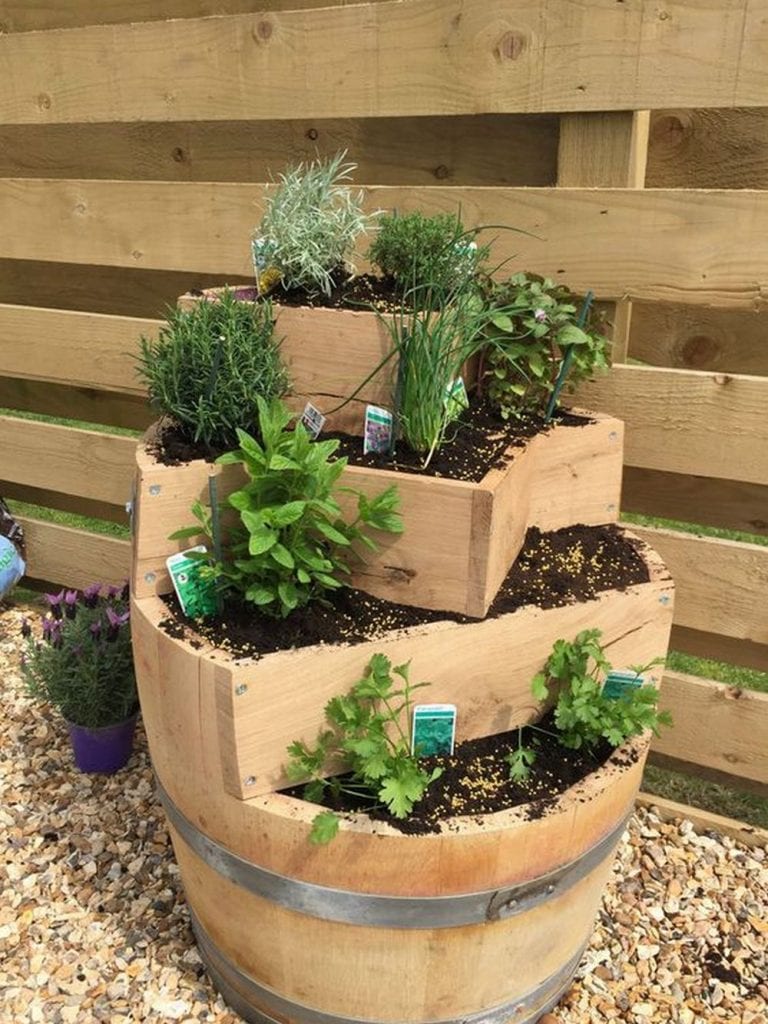


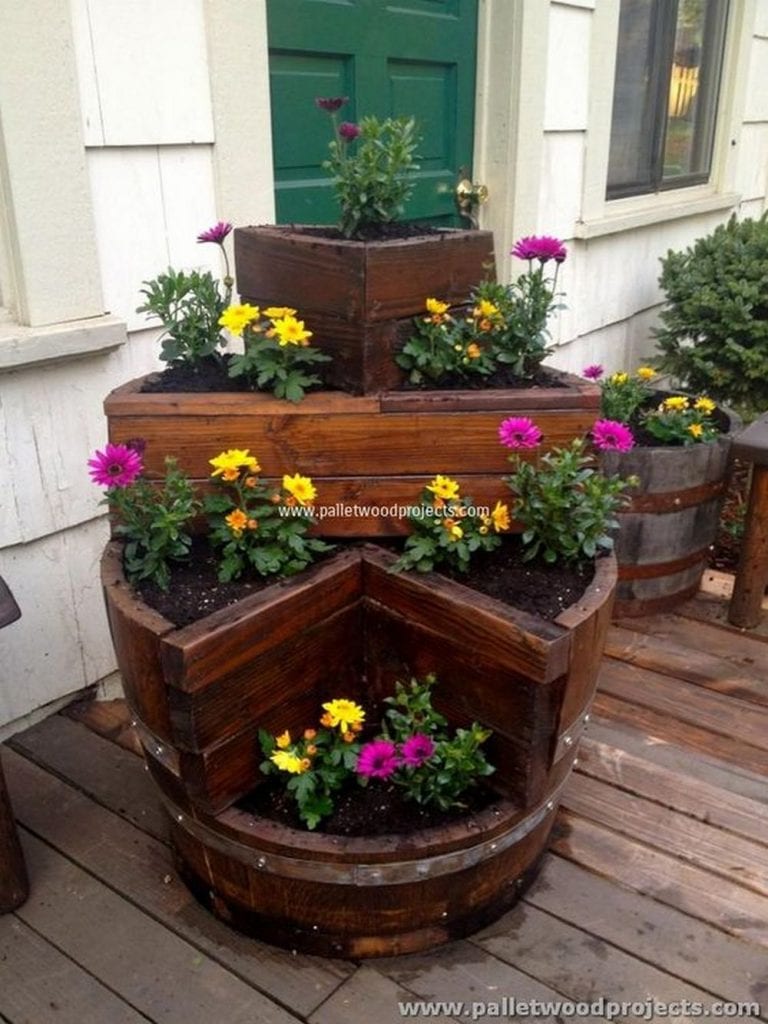
Preparation and Maintenance of Wine Barrel Planters
Wine barrel planters are aesthetically pleasing and incredibly versatile, suitable for various plants from flowers and herbs to vegetables. However, to maximize their potential and longevity, preparing them properly before planting and maintaining them regularly is crucial.
This guide will walk you through the necessary steps to ensure your wine barrel planters remain a focal point in your garden for years.
Choosing the Right Barrel
When creating a wine barrel planter, the initial step is to select a barrel that promises aesthetic beauty and functional longevity. The ideal barrel has retained its structural integrity; hence, inspecting for any significant cracks, splits, or signs of rot is imperative. These flaws compromise the barrel’s durability and can adversely affect the health of the plants it will house.
Barrels that have been stored properly and show minimal weathering are preferable. It’s also wise to consider the barrel’s history—opting for one used to store wine or food-grade products ensures that it is free from harmful chemicals that could leach into the soil and affect plant growth. A well-chosen barrel sets the foundation for a successful wine barrel planter, ensuring it will be a focal point in your garden for years.
Cleaning the Barrel
Before its transformation into a planter, it is crucial to thoroughly clean the wine barrel. This step is essential not only for aesthetic reasons but also to ensure the health and safety of the plants. Start by removing any loose debris from the inside of the barrel. Using a stiff brush and some mild, eco-friendly soap, gently scrub the interior and exterior surfaces of the barrel.
This action helps eliminate any residues of wine or other substances that might still linger within the wood, potentially harming the plants or affecting soil pH levels unfavorably. After scrubbing, rinse the barrel thoroughly with water to remove any soap residue.
A garden hose with a spray attachment works well for this purpose, ensuring that the barrel is ready for the next stage of its transformation. Let the barrel dry completely in a well-ventilated area to prevent moisture-related issues before proceeding.
Creating Drainage Holes
Ensuring proper drainage is a critical aspect of preparing a wine barrel planter. Adequate drainage is essential to prevent water from pooling at the bottom of the barrel, which can lead to waterlogging and subsequent root rot—conditions detrimental to plant health.
To facilitate this, turn the barrel upside down and use a drill with a suitable bit size to create multiple drainage holes in the bottom. Spacing the holes evenly around the base allows for uniform water exit. The number and size of the holes will depend on the size of the barrel and the types of plants you intend to grow.
Generally, 5 to 8 holes, each about half an inch in diameter, should suffice for most applications. For barrels placed on hard surfaces, consider elevating them slightly with bricks or pot feet to enhance drainage and air circulation. This simple yet vital step ensures that excess water can escape freely, providing an optimal plant growing environment.
Adding a Liner (Optional)
Incorporating a plastic liner into your wine barrel planter is a strategic move to prolong its usability and aesthetic appeal. This additional layer acts as a barrier, safeguarding the wood from the constant moisture associated with soil and plant maintenance.
To effectively implement this protective measure, choose a durable and puncture-resistant liner. Carefully measure and cut the liner to fit the interior of the barrel, ensuring it covers the sides completely but does not extend over the rim. Before placing the liner, replicate the drainage holes already drilled in the barrel’s bottom on the liner itself. This alignment is crucial for maintaining the drainage efficiency necessary for plant health.
Using a liner mitigates the risk of wood decay and rot, thus extending the life span of your wine barrel planter without compromising its natural charm and functionality.
Regular Watering
Maintaining optimal moisture levels within wine barrel planters is fundamental to the health and growth of your plants. These containers are prone to quicker drying, particularly in areas exposed to full sun or during periods of elevated temperatures.
To counteract this, a vigilant watering routine is essential. It is advisable to check the soil moisture daily; the top inch of soil should feel moist but not soggy. The watering frequency will vary based on weather conditions, plant type, and the planter’s location. Implementing a consistent watering schedule early in the morning or late in the afternoon can reduce evaporation and ensure water reaches the roots effectively.
For those seeking to streamline this task, considering a drip irrigation system or a self-watering insert can offer convenience while ensuring your plants remain adequately hydrated.
Fertilization
The confined space of a wine barrel planter means that plants have limited access to natural soil nutrients, leading to a quicker depletion of the nutrients available in the potting mix. To address this, applying a balanced, slow-release fertilizer is recommended. This type of fertilizer gradually releases nutrients into the soil, providing a steady supply that supports plant growth over an extended period.
Assess the specific nutritional requirements of your plants, considering factors such as their growth stage and health. Typically, fertilizing at the beginning of the growing season and following up with additional applications as per the product’s recommendation or the plant’s performance can yield the best results.
For edible plants, ensure the fertilizer is suitable for vegetable gardens to avoid harmful substances. Proper fertilization practices ensure your wine barrel planter remains a lush and vibrant garden feature, supporting diverse plant life.
Monitoring for Pests and Diseases
Vigilance in observing the health of your plants within wine barrel planters is crucial for preemptively addressing potential pest and disease issues. The confined space of planters can sometimes facilitate the rapid spread of these problems, making early detection vital. Adopt a routine of inspecting your plants closely and regularly for any signs of distress.
Look for symptoms such as discolored leaves, spots, holes, or insects on the plant or soil. Additionally, monitor for signs of fungal infections, manifesting as mildew or mold on leaves or stems.
Implementing a systematic approach to monitoring can help you catch issues early. This may include checking the undersides of leaves, where pests like to hide, and observing any changes in plant growth or appearance.
If pests or diseases are detected, identify the specific problem and apply the appropriate treatment, such as organic pesticides for pests or fungicides for diseases. Always opt for the least harmful treatment options first to minimize impact on beneficial insects and the environment. Consistent monitoring and prompt action can keep your wine barrel planter thriving and healthy.
Winter Care
Preparing your wine barrel planter for winter is an essential step in regions experiencing cold or freezing temperatures. The goal is to protect the planter from moisture retention and the expansion that occurs when water freezes, as these conditions can cause wood to crack or rot. Begin by assessing whether plants within the barrel are perennial and capable of surviving the winter with protection, or if they should be removed at season’s end.
For planters needing to overwinter plants, consider insulating them with burlap wraps or moving them to a sheltered location, such as against a house wall, to reduce exposure to severe elements. It might be beneficial to store empty barrels upside down to prevent water accumulation or place them under cover to avoid direct exposure to rain and snow.
Additionally, applying a layer of mulch over the soil can help protect the root systems of perennials from freezing temperatures. These steps will safeguard your wine barrel planter through the winter, ensuring its longevity and readiness for the next growing season.
Wood Treatment
An annual wood treatment is recommended to preserve your wine barrel planter’s natural beauty and structural stability. This preventative maintenance helps shield the wood from the elements, preventing weathering decay and extending the planter’s life. Select a wood sealant or preservative designed for outdoor use and, ideally, safe for plants.
Before applying any treatment, clean the barrel thoroughly and allow it to dry completely. This ensures that the sealant adheres properly and provides effective protection. Apply the sealant according to the manufacturer’s instructions, paying special attention to end grains and any cracks or crevices where moisture might penetrate.
A well-applied treatment can enhance the wood’s resistance to water, UV damage, and temperature variations, keeping your wine barrel planter looking its best. Regular wood treatment is a simple yet effective way to invest in your wine barrel planter’s longevity and aesthetic appeal, ensuring it remains a centerpiece in your garden for years.
Conclusion
Crafting a wine barrel planter is a rewarding project that merges aesthetic appeal with practical gardening, offering a sustainable option for repurposing materials while adding a touch of rustic charm to any outdoor space. These planters provide an ideal environment for various plants, enhancing garden versatility and promoting efficient use of space. Ultimately, the wine barrel planter stands as a testament to the beauty and functionality achievable through creative gardening solutions.
Are you looking for ways to grow plants in a small outdoor space? Check out our containers for compact gardening next!

